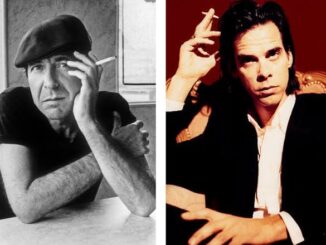
In the twilight corners of modern songwriting, few artists weave grief, longing, and love with the same raw intensity as Nick Cave. Through decades of musical evolution, from the anarchic chaos of The Birthday Party to the lyrical mournings of the Bad Seeds, Cave has remained a poet of the human condition. But behind the growl, the myth, and the melancholy stands one figure who has shaped much of his later work his wife, Susie Cave.
“The Ballad That Became Memory” is not just a poetic phrase. It is a window into the delicate, aching beauty of a relationship that has both endured and inspired. For Nick Cave, Susie Bick now known as Susie Cave, the fashion designer and founder of The Vampire’s Wife has been more than muse. She is, in many ways, the quiet center of his storm.
When Cave speaks of Susie, it’s with reverence rarely afforded in public discourse. She has been the subject of many of his most intimate songs, most notably in albums like Push the Sky Away and Ghosteen. In “Breathless,” from Abattoir Blues/The Lyre of Orpheus, he serenades a love so pure it seems unshaken by worldly grief. But that purity was eventually tested by unspeakable tragedy.

The death of their son Arthur in 2015 cast a long shadow over the Cave household. It was a loss that echoed through every corner of Nick’s creative output, especially in Skeleton Tree and Ghosteen, two albums that feel like open wounds set to music. Through that heartbreak, Susie became a silent figure in the songs not just as the subject of longing or devotion, but as a symbol of survival.
In interviews, Cave has described Susie as “the person who holds everything together.” She, too, suffered publicly and privately, retreating at times from the fashion world she had conquered. But her resilience chiseled into elegant dresses, immortalized in Cave’s words spoke of a woman who mourns with grace and creates with defiance.
Cave once wrote on his Red Hand Files, his open forum for fan correspondence: “We each carry our grief in our own way. Susie carries hers with immense dignity.” It’s a simple line, but it says everything. In a world where pain often tears people apart, Nick and Susie held tighter. Their love morphed. It deepened. It became something beyond romantic poetry a shared act of endurance.
Susie has always walked the line between mystery and presence. As a former model for Vivienne Westwood and a designer whose aesthetic leans into the gothic, she embodies the same duality that defines Cave’s work. Ethereal and grounded, lost and found, mythic and maternal.
Their bond is a ballad, yes but one where verses have been rewritten by time, and choruses softened by shared sorrow. It is no longer just about courtship or inspiration. It’s about what remains when the music stops, when the cameras fade, when the world looks away. That’s the memory Nick Cave carries now a living one, shaped not only by beauty and desire, but by endurance and vulnerability.
In many ways, Nick Cave and Susie Cave have become one of art’s great quiet love stories. Not in the explosive, paparazzi-fed way that floods tabloids, but in the solemn, poetic style that creeps into the listener’s bones. Theirs is a relationship you don’t need to see to feel it’s in the chords, the lyrics, the silence between notes.
And as Cave continues to write, tour, and reflect, the memory of Susie as muse, mother, anchor, and ally endures. Not as a fading echo, but as a continuing refrain.
In the end, the ballad didn’t end. It simply changed form and became memory.




Be the first to comment